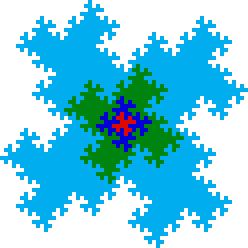
| Instead we return to our original shape with four copies. |
| Again, select and group these five to make a shape. |
| Fit four copies of these around the central shape. |
| Select and group these five, reduce the size of this new shape to keep the aggregate of manageable size, and place four copies around the central shape. |
| Some care must be taken when placing these copies since they will fit into the central shape in many different ways, but not all will produce a tessellation. |
 |
| Note that in going from one stage to the next, we are replacing the area by 5 times the
area and the perimeter (measured at this scale) by |
| The area-perimenter relation becomes
|
Return to Method 1.